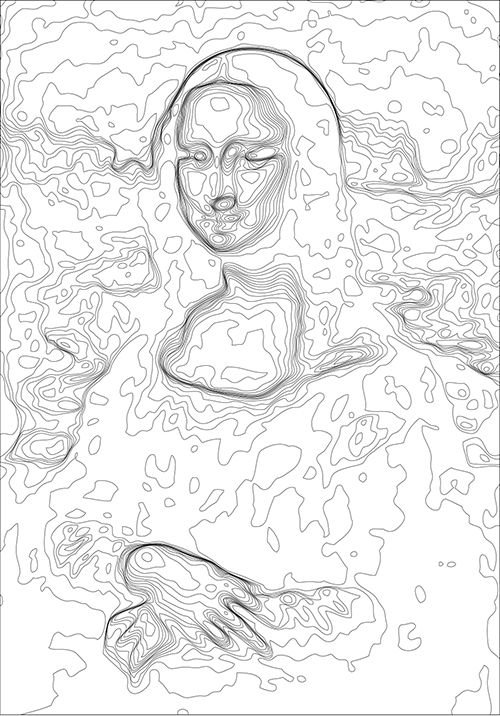
Walking within the Mona Lisa
In 2011 I presented a solo exhibition called DOUBLE TAKE in which I explored the possibilities of creating and discovering new worlds hidden within well-known imagery. In one of my original works, I derived a landscape topography from the Mona Lisa, built the topography using lasercut plexiglass, and then created a hand-drawing of the landscape. When viewed from above the Mona Lisa's famous gaze is clearly visible, but from all other angles the viewers are afforded a completely new relationship with the image they've seen countless times before.



Visitors to the exhibition were presented with the following blurb upon entry:
The Mona Lisa lies flat below your feet, the size of a football field. As you walk the fifty yards up her torso, her legendary smile is lost within your ground-level view. An image of iconic status can be increasingly manipulated in color, scale, material and orientation, but still it remains recognizable – that is, until an unexpected moment of lost familiarity and intense reinterpretation. It is at this moment that I present to you: the double take.
Found at the unstable line between two-dimensional and three-dimensional representation, we find endless possibilities for creating originality through perceptual transformation. Unknown worlds begin to emerge within the most well known imagery. This same stubborn line separates an architectural plan from its seemingly unreachable three-dimensional product, and applying this notion to iconic works of two-dimensional art adds new levels of both literal and abstract depth to the works. With the sudden ability to participate in what was once a mutually exclusive relationship, the spectator takes on the role of the settler. As we know her, Mona Lisa is not a woman, she is a painting. As soon as she turns her head, uncharted territory manifests.
How did I make this?
The process for creating the topography was based on one understanding: the darkest portions of the painting should be the valleys and the lightest portions should be the mountains. That way the darkest portions (her eyes, hair, smile) would be the parts of the landscape with the deepest darkest shadows, while the lightest portions (her face, chest, hands) would catch the most light.

I derived the layers of the topography by taking the painting into photoshop, converting it to black and white, and then gradually adjusting the “Threshold” levels. In this way I was able to tease out twenty layers which start with the lightest portions as the top layer of the topo, gradually getting darker and darker as the layers get lower and lower.

These twenty layers were then taken into Illustrator and “Image Traced” in order to get the outlines. The next and last step was sending those outlines to the laser cutter and glueing the twenty layers together by hand, one piece at a time!

This sculpture/drawing was one in a series of five, each based on a different famous image. Let me know what you think of this idea/method and feel free to ask any questions! Follow me to see more of this series in the future.

